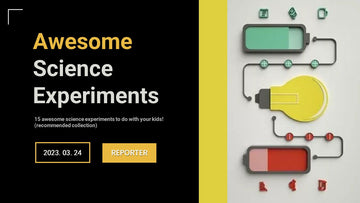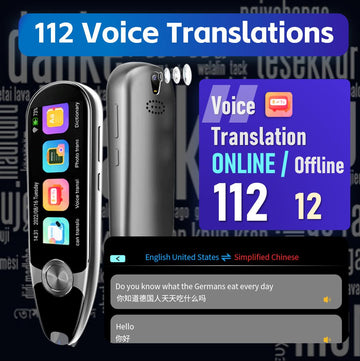15 awesome science experiments to do with your kids! (recommended collection)
by HeJiang Peng on Mar 24, 2023
Recharge your batteries at home with your kids - 15 fun science experiments!
Vormor is committed to solving the problem of sharing interesting teaching inspiration and solving communication barriers. We not only pay attention to communication, but also let children discover the joy of knowledge in interesting practice.
1. Flowers that change color

Material preparation: white carnations , food coloring, water, cups
Production Method:
(1) Pour the same amount of water into the cups, and drop a few drops of food coloring into one of them
(2) Put the flowers into transparent bottles respectively, and observe the color change of the flowers after a few days.
scientific knowledge:
The stem is one of the vegetative organs of the plant, which supports the plant and transports water and nutrients. The stem of the plant can transport the water and nutrients absorbed by the root to all parts of the plant from bottom to top. The flowers in the vase change color precisely because the stems channel the blue ink.

Scientific experiments have shown that the electricity charged by objects due to friction is either positive or negative. The same charge as the glass rod rubbed with silk is called positive charge; the same charge as the rubber rod rubbed with fur is called negative charge. Like charges have the property of repelling each other, while different charges attract each other.
Since the two balloons are charged with the same kind of charge after being rubbed by the flannel, they will repel each other and naturally separate.
3. Battery family

Material preparation: various types of batteries, electric toys and a battery family diagram.
Experimental operation:
(1) Let the children observe the shape and characteristics of the batteries, and classify or line up the batteries according to the model and function.
(2) Guide children to choose a suitable battery, put it into the electric toy according to the correct method, and make the electric toy move.
A battery is a general term for a small device that generates electricity, such as a solar cell. The chemical batteries we usually use can be divided into primary batteries and storage batteries. The primary battery can generate current after it is made, but it is discarded after discharge. The storage battery is also called a secondary battery. It can be discharged after charging, and can be charged and reused after discharging.
At present, our general-purpose disposable batteries mainly include carbon batteries and alkaline batteries. Generally, each cell is 1.5V and is cylindrical. The common models are No. 1, No. 5 and No. 7. The larger the number, the smaller the model. When we correctly install the battery into the electric toy, turn on the switch, the battery can provide current to the circuit, and at the same time convert the electrical energy into mechanical energy, and the toy can move.
4. Magnetic field lines

Material preparation: a small plate, a plastic bag; a piece of craft paper, some iron filings; a bar magnet.
Experimental operation:
1. Put the magnet in a plastic bag, then stir it in the sand, then take out the plastic bag and put it in a small plate, take out the magnet, the iron filings will fall, and you can get a lot of iron filings after many times.
2. Put the magnet on the handmade paper, sprinkle the collected iron filings evenly around it, tap the handmade paper lightly, and due to the effect of the magnetic field, the pattern of magnetic force lines will appear on the paper.
5. A beautiful rainbow

Material preparation: two plastic water bottles, a compass; an awl, some water; a small sewing needle.
1. Use a sewing needle to poke about 20 small holes in the plastic bottle cap, fill the plastic bottle with water, close the cap tightly, hold the bottle with your back to the sun, squeeze it gently to make the water spray out. I can see the rainbow.
2. Use an awl to poke holes in the cap of the other bottle and repeat the experiment above, this time no rainbow will be seen in the light rain sprayed from the cap.

1. Use an empty glass milk bottle and put more than half of the bottle of water into the bottle;
2. Use scissors to cut a hole at about one-third of the long straw, so that it is almost disconnected, but still connected a little;
3. Make the straw bend at the cutting place, insert the longer part of the straw into the water, and the cut is on the water surface, and you will hear the sound when you blow hard on the straw, adjust the position of the straw in the water, and the sound will change again.
7. Homemade spinning top

(1) Decorate the disc with various post-it notes, and then insert a small wooden stick of moderate thickness through the small hole in the disc and fix it.
(2) Let the children twist the top hard, then let go, let the top spin, and see whose top spins the longest.
scientific knowledge:
Spinning top is an ancient Chinese children's toy, which is a revolving body that turns on the ground. When the top rotates, it not only rotates around its own axis, but also makes a conical motion around a vertical axis .
To make the top stand up, external force must be constantly applied. Once the help of the external force is lost, the top will fall down soon, because the top of the top is too small to support its own weight. The length of time for the gyro to rotate is related to the distance between the fulcrum and the ground, the force applied during rotation, the contact area between the fulcrum and the ground, and the frictional force.
8. Homemade hourglass

Material preparation: several identical mineral water bottles (bottle openings of different sizes), sand, and a stopwatch.
Experimental operation:
(1) Two identical mineral water bottles form a group, and an appropriate amount of sand is filled in one of the mineral water bottles. The amount of sand contained in each set of bottles remains the same.
(2) The mouths of each group of mineral water bottles are facing each other and tied tightly with scotch tape. Simple decoration can be done on the bottle body, and the hourglass is completed.
(3) Ask the children to reverse a set of hourglasses, observe the flow of sand, and record the time when the sand flows out.
(4) Ask the children to invert several hourglasses with different sizes of bottle mouths at the same time, and compare the different times when they run out.
scientific knowledge:
Give the sand an external force, and the sand can flow. Constantly turning the hourglass is equivalent to giving the sand an external force, so the sand can flow. The flow rate of the sand is related to the size of the hourglass bottle mouth and the number and diameter of the cap eyes: the larger the bottle mouth, the more cap eyes and the larger the diameter, the faster the flow rate; the smaller the bottle mouth, the fewer cap eyes and The smaller the diameter, the slower the flow rate.
An hourglass, also called a sand clock, is a device for measuring time. The hourglass is composed of two identical bottles up and down, which are connected together with a narrow connecting pipe in the middle. The fine sand in the upper bottle slowly flows into the bottom bottle through the middle thin pipe. The time required for this process can be used to Time is measured. Once all the sand has drained into the bottom bottle, the hourglass can be turned upside down to measure time. The advantage of this hourglass is that it can be used on both sides, and when it is turned over, the bottom can become the upper part and continue to be used.
9. Homemade Fountain

Material preparation: two larger empty beverage bottles (such as Sprite bottles), tacks, water
Experimental operation:
(1) Punch several small holes with the same diameter and size vertically on one side of the bottle body of a Sprite bottle .
(2) Prick several small holes with different diameters and sizes on the cap of another Sprite bottle.
(3) Let the child fill the first bottle with water, and the water will spray out from the small hole in the bottle body, and the water sprays at different distances.
(4) Let the child fill the second bottle with water, tighten the bottle cap, and squeeze the bottle body hard, and the water will spray out from above like a fountain.
scientific knowledge:
10. Homemade bubble water

Material preparation: washing powder, dish washing, soap flakes , small spoons, water, cups.
Bubbles are formed due to the surface tension of water. Usually, the attraction between water molecules is stronger than the attraction between water molecules and air. These water molecules seem to be stuck together, but if the water molecules are too glued together, bubbles are not easy to form. Laundry powder "breaks" this surface tension of water, and it reduces the surface tension to only 1/3 of the usual situation, and this is the optimal tension needed to blow bubbles.
The mixing ratio of bubble water will affect the effect of blowing bubbles. Generally, the bubble water prepared with 2 parts of meal wash and 6 parts of water can be used. Glycerin is a hygroscopic liquid that, when combined with water, forms a weaker chemical bond that slows the rate at which the water evaporates. Therefore, in order to make the bubbles not disappear so quickly, you can put some glycerin in the bubble water. Under normal circumstances, the best formula for bubble blowing solution is: 2 parts of meal washing, 6 parts of water and 1-4 parts of glycerin. We can see colorful lights through the bubbles because of the refraction of light rays as they pass through the soap bubble's membrane.
11. Funny tumbler

Materials preparation: plastic ping pong balls, plasticine, colored paper, watercolor pens, sand, mung beans.
(1) Cut a small hole in the plastic table tennis ball, and stick the plasticine on the middle of the inner bottom of the ball as the body of the tumbler.
(2) Use colored paper to make a cone and draw the five sense organs as the head of the tumbler.
(3) Bond the cone and the plastic ball with an adhesive to make a tumbler.
(4) Let the children push the tumbler with their hands, observe its swing state, and see if it will fall down.
(5) Distribute table tennis balls to children, change the weight of the plasticine and its position in the table tennis ball, observe whether the tumbler will fall down, and let them understand that the lower the center of gravity of the tumbler, the more stable and balanced the tumbler will stand.
(6) Let the children fill the table tennis with various materials such as sand and beans, and then push the tumbler to observe its changes, so that they can understand that only when the object is fixed can the tumbler not fall down.
Scientific knowledge:

Experimental operation:
(1) Put the three objects on the floor, let the children shine them with a flashlight, observe and record their shadows.
(2) Change the position of the flashlight to illuminate the small doll (opaque object), observe and record the shadow formed by the doll.
(3) Keep the flashlight still, change the distance between the doll and the flashlight, and observe the change in the size of its shadow.
scientific knowledge:
If light is blocked by an opaque object when it travels in a straight line, a shadow will be formed on the back of the object. Light can completely pass through transparent objects, so completely transparent objects cannot form shadows; when light passes through translucent objects, part of the light will be transmitted, forming a translucent shadow. The shape and size of the shadow will be different depending on the angle of light irradiation. The distance between the object and the light source is different, and the size of the shadow is also different.
13. The little hedgehog grows thorns

Material preparation: magnets, iron filings, rectangular plastic trays, white paper of the same size as the bottom of the tray, and crayons.
Experimental operation:
(1) Draw a little hedgehog squatting under the apple tree on the paper, pay attention not to draw the thorns on the hedgehog.
(2) Spread the painting on the tray.
(3) Gently sprinkle the iron filings on the painting, then place the magnet under the tray, move the magnet gently, and attract all the iron filings to the little hedgehog, helping the little hedgehog grow spikes.
scientific knowledge:
Magnets can attract iron objects, and the finely divided iron filings can show unique artistic shapes under the attraction of magnets. The iron filings can also show the existence of the magnetic field of the magnet. Using the effect of the iron filings on the magnetic field lines, the children can vividly perceive the distribution of the magnetic field lines of magnets of different shapes.

Material preparation: newspaper, electro-optical paper, paper towel, kraft paper, dropper , water basin, ruler, tape.
Experimental operation:
(1) Cut newspapers, electro-optical paper, paper towels, and kraft paper into long strips of the same size, and then stick one end to the ruler with tape so that the lengths of the hanging paper strips are the same. Put the ruler above the water surface with your hand, let the paper strips be immersed in the water at the same time, and let the children observe which paper strip's water rises faster, which means it has a strong water absorption capacity.
(2) Spread these four different papers on the table, and drop the same amount of water droplets on each piece of paper at the same time, and see which kind of paper the water droplets spread the fastest.
scientific knowledge:
There are many tiny holes inside the plant fiber of paper, and at the same time, the attraction of fiber to water is greater than the attraction between water molecules, so that it can attract and retain water molecules under the action of gravity, which is called the water absorption of paper. Because the size and number of holes in the plant fibers of different papers are different, their water absorption strengths are also different.
15. Magic papermaking

Material preparation: waste paper, water, glue, rubber gloves, plastic board, gauze, wooden stick .
Experimental operation:
(1) Soak the waste paper and shred it, the smaller the better, and then soak it in an appropriate amount of water.
(2) Let the child wear rubber gloves to crush the soaked paper, add glue and stir evenly with a wooden stick.
(3) Put the prepared pulp on gauze for dehydration, then evenly spread it on a plastic plate, flatten it and dry it.
(4) Let the children feel the fun of making paper by themselves, and write and draw on the dried paper.
scientific knowledge:
Paper is a sheet-like fiber product used for writing, printing, painting or packaging. Generally, it is made of water suspension of plant fibers that have been pulped, interlaced on gauze, dehydrated initially, and then compressed and dried. China is the first country in the world to invent paper.
In the very early days, 'our ancestors carved characters on tortoise shells and animal bones, and later on bamboo slips', but these things were very bulky. Later, it was also written on silk, although it was much lighter, it was very expensive. About 2,000 years ago, Cai Lun of the Eastern Han Dynasty invented paper made of common or waste materials such as bark and rags, which was very suitable for writing, and it slowly spread throughout the world.
Finally, we recommend our VORMOR X5 Pro Dictionary Pen
Collins Dictionary can be translated from English to English, with over one million thesaurus and example sentences, you may like it for your homework, haha
like this






